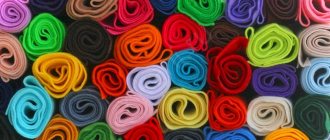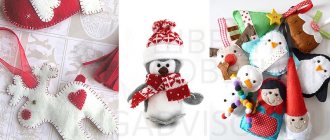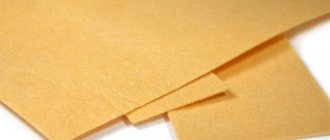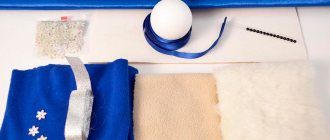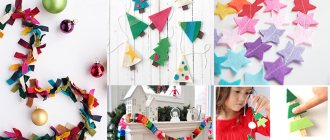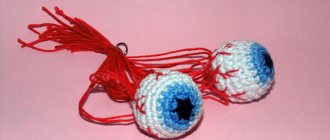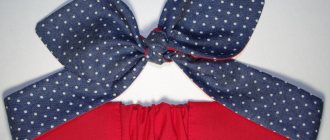How to glue felt together
Tools for working with felt fabric:
- Regular scissors;
- Nail scissors;
- Roller for cutting fabric;
- Punch;
- Pins, needles, double tape, fabric chalk;
- Fabric adhesive, the choice depends on the type of connection.
You need to choose glue very carefully when working with felt.
What does the base look like?
The main brands are presented below:
- FG40Z. It is designed to work with different fabrics. It dries quickly, does not leave streaks, and can be washed off with water if desired. The jar has a thin dispenser, so it is convenient to work with small elements. Does not contain chemicals in its composition.
- "Moment-Crystal". It glues very tightly, the substance itself is transparent. It is recommended to apply with a brush because it is very liquid. Not allowed for use by people who are allergic to chemical additives.
- "UHU Creative". Quickly fixes felt fabrics, padding polyester, wool, chintz and other materials. Can be combined with cardboard or paper. Mainly used for crafts, easy to wash off with water.
To choose what to glue the felt with, you need to decide on the base (paper, cardboard, fabric, wood).
Moment-Crystal transparent
Why can't you use PVA glue?
Some people use PVA when working with textiles, this is a big mistake, only universal glue is needed.
Regular PVA is used only when working with paper or cardboard. If you use it on fabrics, it will leave yellow stains.
It is better not to use white and thick glue at all, as it forms lumps.
Attach with silicone
For easy and enjoyable work, you need to choose good tools. The glue gun belongs to the category of electrical appliances; it runs on mains power and heats the silicone inside. During the process, it flows out of the gun onto the work surface. If you will only be working with fabrics, then you can buy a gun with a 7 mm rod, this will be quite enough.
Silicone rods
The length of the rod depends on the quality of work; if you take very short ones, you need to constantly change them
When purchasing a gun, you need to pay attention to the heating temperature. For classic rods, heating up to 100 degrees is enough; if the temperature is higher, then the melting rate is accordingly, which means the work goes faster
This is one of the practical methods, the connections are strong and time costs are reduced. To work you need to use a glue gun.
- Insert silicone inside;
- Turn on the glue gun;
- Within a few minutes the silicone will begin to melt;
- Start working with the gun;
- At the end of work, turn off the gun and remove excess residue from the dispenser.
Gun for work
You need to work quickly with such a gun; the silicone dries instantly, and then it will be difficult to remove it from the craft. Such a gun is needed not only for crafts, but also for repairs.
Gluing with regular glue
It is necessary to apply it carefully, without staining unnecessary places, so that the fabric does not become saturated with it where it is not needed.
- Must be clean and dry;
- Apply with a brush in one thin layer;
- After 5 minutes, press firmly on the fabric to stick it.
After choosing the material, it needs to be prepared for work. Regular glue needs to be shaken well, when working with a gun you need to evaluate its technical condition, and if Moment is used, then the room should have good ventilation.
Application options
Before starting work, you need to evaluate the effects of the glue on the fabric. It must be applied in a thin layer so that it is not completely absorbed into the fabric. If this happens, the Moment Crystal will appear on the back of the product, and then streaks will appear. If this happens, you can make a duplicate of the material.
These items can be washed in a machine on a delicate cycle. It is not advisable to wring out; drying is carried out only at room temperature, in a horizontal position. Otherwise, the craft or thing may stretch. Since the felt is quite dense and rough, there is no need to iron it.
Direct exposure to sunlight should be avoided because the fabric can dry out and become very brittle.
Felt tape
When washing by hand, do not wring or twist the fabric too much, as this may cause pilling. If the fabric is not very dirty, then dry cleaning with a coarse brush is sufficient.
How to remove glue residues - useful tips
There are several methods to remove excess residue:
- PVA transparent. It can be removed with warm water or pure alcohol;
- Creative. Can be removed with cold water and a pinch of baking soda. You need to moisten a cotton swab in the solution and rub it over the remaining glue;
- Moment Crystal. This glue can be easily removed with solvent or alcohol diluted with water;
- Silicone. You need to put the craft in the freezer and wait for the glue to cool. Due to frost, it becomes brittle; it can be removed by hand or with a knife. You can also use acetone.
Attention! Before starting work, you need to conduct a test on the effect of felt with glue.
Self-adhesive felt can be bought in textile stores, or in places where there is everything for needlework. Typically, adhesive-based felt is sold in 30x30 sheets, with a protective film. You can also purchase sets of 10-15 colors at once. These are mainly needed for school work.
Ice cream made from multi-colored self-adhesive felt
In conclusion, we need to summarize. That adhesive-based felt is great for making not only crafts, but also for decorating various items of clothing. It is important to choose the right glue, otherwise there is a risk of damaging the product after the first wash. If you have any doubts about your choice, you can contact your sales consultant and find out how to glue the felt to the fabric.
«>
How to glue at home
DIY pig costume.
5 best ideas with photos If there is a need to glue polyethylene at home, then you need to use IZ products. The gluing process depends on what base the film is attached to.
Interesting video on the topic:
Between themselves
The polyethylene film will stick to each other BF-2. But before work you need to prepare:
- The surface is thoroughly cleaned of dirt, dust deposits, and degreased.
- Apply a layer of adhesive, distribute evenly, connect the surfaces.
- Press for a couple of hours until the mass sets.
This preparation is suitable for all types of connecting compounds.
Glue - toxic compounds, work is performed with gloves.
In addition to glue, double-sided tape, soldering the ends between two metal plates, or molten plastic will help to glue the film.
To metal
In order for the polyethylene to tightly and reliably cover the metal surface, you need to do the following:
- the metal plane is cleaned and degreased;
- warms up to 120–150 degrees;
- the film is carefully stretched, gradually applied to a metal plane, and rolled.
To concrete
It is not difficult to stick insulation to concrete, the main thing is to follow the rules:
- the concrete surface is cleaned, leveled, primed;
- glue is applied to the side of the insulation where there is no foil;
- wait a minute for the glue to soak in;
- apply cloth, press;
- the edges are additionally coated and fixed;
- wait until it dries completely.
Application
Washable fabric marker for painting and marking when cutting
Felt is used to make:
Shoes. Classic children's felt boots are essentially the same felt, only in this case the products are felted straight away, without seams. Boots, shoes, felt slippers provide your feet with comfort and warmth. And the variety of colors, styles and finishes allow felt shoes to compete with leather ones.
Headdresses. Berets, helmets and other styles - here felt also takes a leading position. And among hats and bath caps he simply has no equal.
Bedspreads, rugs.
Crafts, applications.
Jewelry.
Toys.
For technical purposes: seals, gaskets, filters.
What glue is suitable for felt?
What glue is suitable for fabric?
To make a toy or cover the surface of furniture with this material, you can use an adhesive composition. To do this, you need to find out what kind of glue to glue the felt with and how to use it correctly. There are several proven and positively proven compositions.
Adhesive "Creative" for fabric and wool
This product can be put in first place. UHU Creativ glue is a quick-setting adhesive composition that is ideal for gluing wool, felt, cotton, cotton wool, various types of fabric, and satin. If, after gluing, you additionally iron the seam, it will be resistant to chemical cleaners and washing.
After drying, the glue becomes transparent. It is not recommended to use for joining materials that consist of 60% or more synthetic fibers.
Clay Radical (Anles)
Black, universal, especially durable and frost-resistant composition. Easily used when gluing various combinations of wood, metal, plastics, glass, porcelain, ceramics, concrete, felt fabric, paper.
A one-component cold-curing mixture based on chloroprene rubbers. A varied range of containers: euro buckets in 20 liter containers, liter jars and 40 ml tubes.
BRAUBERG universal adhesive for any materials
Chinese product for quick work, not resistant to washing, ironing, and all cleaning agents. Universal for its purpose, which is used for gluing the following materials:
- Tree.
- Plastic.
- Porcelain.
- Textile.
- Glass.
- Metal.
- Leather.
- Cardboard.
- Textile.
- Felt.
After drying, the adhesive mass becomes transparent. Does not like prolonged exposure to moisture. The finished seam has a high elasticity index.
Henkel glue, Moment
Just like the previous composition, it is a universal glue. However, according to its characteristics, it is waterproof. Designed for gluing rubber, leather, wood, metal, felt, glass, porcelain, ceramics in various combinations. The glue seam turns out to be very reliable.
How to choose glue for felt
Before purchasing craft glue, find out the composition of the felt. Synthetic materials absorb moisture better, so the consistency of the glue should be more viscous. Otherwise, the fabric will absorb the solution until it is soaked through. In this case, stains or a hard crust will remain on the surface after drying.
In addition, the glue for felt for decorative finishing should be:
- Colorless and dry quickly.
- Do not have a strong chemical odor or dissipate quickly.
- The composition must have high elasticity, since the material is constantly subject to deformation.
The most common brands of felt glue are:
- UHU Textile fabric adhesive.
- Moment Crystal.
- PVA.
- Hot glue gun.
Application of felt textiles
What can you make from felt? We already know that all types of felt have many types; designers often buy it for their work, also for hand-made artists and even for creating interior details, for example, in furniture upholstery.
Felt in clothes
Most often, felt fabric is used for sewing coats. You can sew all kinds of hats, sweaters, jackets, and even trousers.
These types of clothing are sold in specialized stores. Shoes made from this material are also popular, because items made from felt are distinguished by their heat-saving properties.
Automotive
What is felt for the automotive sector? It is used in the manufacture of automobile filters and gaskets.
Felt material is used to create seals, the upholstery of the cabin itself, and in some cars, in the glass frame (as insulation).
For needlework
The master needs to decide on the craft he will make in order to understand what type of felt he will use to complete his masterpiece. For example, polyester felt is suitable for sewing toys, and thick types of felt are suitable for bags and books.
Now it has become fashionable to make sensory educational materials for children, and felt also plays a significant role here. Thin felt is used in all kinds of applications using the cutting and pasting method. When creating a variety of flower bouquets, candies, gift wrapping, and the like, craftsmen use floral felt, which is quite thin and paper-based.
At the moment, such bouquets are trendy and look decent. For beginning craftsmen, small kits are sold that include tools for processing felt, the material itself and instructions.
How to replace felt for needlework? Choosing the best materials for replacement crafts
– Not long ago I became interested in needlework. I make all sorts of crafts and constantly use felt for them - it turns out to be a very convenient material. But in our stores there are shortages of felt - sometimes it’s on sale, sometimes it’s not delivered. What fabric can replace felt for needlework without losing quality?
- Felt . This is a natural material made from felted wool. It is the closest possible replacement for felt. Since felt can be either quite thin or very dense, the first option is most often chosen for needlework. Thin felt can be easily cut with ordinary scissors.
- Drap . This is a dense material made from natural wool. It is usually used for making outerwear, and nowadays needlewomen are increasingly using it to create toys. Drape varies in density, so you can choose the appropriate option for needlework.
- Fleece . This is a synthetic material with a pile surface. However, fleece, unlike felt, is soft in structure, so it may not be suitable if you need a material that can hold its shape when working. To make the fleece more dense, you can try rolling it in several layers.
These are the most popular felt substitutes, but you can also try using any thick woolen materials. At the same time, you don’t have to buy a piece of fabric - you’ll probably have old, unnecessary clothes that you can cut out and give them new life.
Below you can familiarize yourself in more detail with the characteristics and photographs of the materials described.
What glue is suitable for felt?
To make a toy or cover the surface of furniture with this material, you can use an adhesive composition. To do this, you need to find out what kind of glue to glue the felt with and how to use it correctly. There are several proven and positively proven compositions.
Adhesive “Creative” for fabric and wool
This product can be put in first place. UHU Creativ glue is a quick-setting adhesive composition that is ideal for gluing wool, felt, cotton, cotton wool, various types of fabric, and satin. If, after gluing, you additionally iron the seam, it will be resistant to chemical cleaners and washing.
After drying, the glue becomes transparent. It is not recommended to use for joining materials that consist of 60% or more synthetic fibers.
Clay Radical (Anles)
Black, universal, especially durable and frost-resistant composition. Easily used when gluing various combinations of wood, metal, plastics, glass, porcelain, ceramics, concrete, felt fabric, paper.
A one-component cold-curing mixture based on chloroprene rubbers. A varied range of containers: euro buckets in 20 liter containers, liter jars and 40 ml tubes.
BRAUBERG universal adhesive for any materials
Chinese product for quick work, not resistant to washing, ironing, and all cleaning agents. Universal for its purpose, which is used for gluing the following materials:
- Tree.
- Plastic.
- Porcelain.
- Textile.
- Glass.
- Metal.
- Leather.
- Cardboard.
- Textile.
- Felt.
After drying, the adhesive mass becomes transparent. Does not like prolonged exposure to moisture. The finished seam has a high elasticity index.
Henkel glue, Moment
Just like the previous composition, it is a universal glue. However, according to its characteristics, it is waterproof. Designed for gluing rubber, leather, wood, metal, felt, glass, porcelain, ceramics in various combinations. The glue seam turns out to be very reliable.
Felt technology
When it became clear how to glue felt, you need to learn all the ways to connect pieces of felt:
- Thread stitch. It is considered the highest quality. Polyester threads are most often used for this. To highlight the beauty of the decoration, you need to use floss threads.
- Glue seam. Before using the adhesive composition, it is advisable to test it on unnecessary pieces or scraps. This is due to the fact that many glues leave yellow marks after drying.
Another option for connecting individual pieces of felt is double-sided tape. This is the most unreliable option, since the livestock quickly dries out and the seams begin to unravel.
Felt classification
To get a decent piece of felt work, you should know which of all types will be used, so you need to study in detail the features of any type of felt.
Types by density
If we talk about felt by density, it is divided into 3 types:
- The felt is thin (soft) - its thickness is from 1 to 1.5 mm; small parts and appliques are mainly made from this felt.
- Medium thickness - 3 mm fabric, used as “felt for needlework”, also for interior elements, toys, etc.
- Felt is hard (thick) - the thickness of this type reaches 5 mm; this type is used as a base, and is also used to make books. Its color range is less rich compared to other species.
If we talk about the classification of the composition, it is divided into: woolen, simulated and artificial.
Pure wool felt
Pure wool is mainly made from rabbit, sheep or goat hair. This type is soft, very durable, but the pile shrinks quickly. It is the most expensive type of felt.
Wool blend felt
Simulated or called half-wool felt, it contains various additives, mainly viscose, less often acrylic, in approximately equal parts, so it is the most affordable. It is softer compared to the above. It is better not to use it for children's toys.
Acrylic felt
Artificial types of felt include: acrylic felt, which differs from others in its shine and is “slippery” to the touch, slightly transparent. This felt fabric is quite rigid, this is due to the fact that it is a product of plastic processing and is cheap. This felt is very easy to clean and would be great for something very small – keychains, etc.
Viscose felt
Another type of artificial fabric is felt made of viscose; it is quite dense compared to the previous one, soft and holds its shape well. But caring for it is very painstaking, which is why people do not prefer to sew things from it, because they may soon lose their shape.
Polyester felt
And, polyester felt has good wear resistance, is dense and soft. Used for durable items. It can be used for both large products (clothes, bags) and small ones (jewelry, keychains). We can conclude that this type is universal. But you need to take into account that light colors can show through.
What is felt
Felt can have different compositions. Most often it is divided into wool and synthetic. To choose the appropriate option, it is worth considering the characteristics of the materials.
Pure wool
This type of felt is also called wool felt. Beginners rarely use this material. It has a high cost because it has a completely natural composition. Professional craftsmen use the material to create small objects - toys or jewelry. This type of felt is also good for decoration.
Wool blend
This kind of felt is used for needlework much more often. There are many colors available for sale. In addition, the material has a flat and smooth surface. At the same time, it is considered less natural. The substance consists of only half wool. The remainder is made up of viscose and acrylic. Wool-blend felt has a lower cost than natural felt. However, it should not be used to create children's things. The material is not suitable for large products. At the same time, it is permissible to make toys or applications from it. This felt is used for decorative purposes.
Acrylic
This material is affordable. It is most often used by beginning craftsmen. However, professionals do not recommend using acrylic felt. It is considered not of very high quality and quickly loses its original appearance. The material is characterized by shine and the appearance of gaps. It also often breaks. At the same time, acrylic felt is easy to clean and has a pleasant texture. It is characterized by a variety of colors. However, this material should not be used to create large things.
See also
Types of adhesive compositions for polycarbonate and do-it-yourself rules for use
Polyester
This high-quality material has an affordable price and is popular among beginners and professional craftsmen. You can create beautiful and comfortable things from this felt. Polyester is highly durable. It is permissible to make items from it that are planned to be actively used and washed. There are many different colors available for sale. The material is suitable for creating large objects and small products.
Viscose
This material has an affordable price and high quality. Viscose felt comes in a variety of colors. It is considered very durable and soft. At the same time, the material requires careful handling, otherwise products made from it can quickly lose their shape.
Most often, viscose felt is used to create small objects. These could be toys or jewelry. The material is also suitable for decoration.
What glue to glue felt with - review
To work with felt you will need cutting, drawing and fastening tools.
- Standard scissors;
- Embroidery scissors – for cutting out small details;
- Roller knife - for even cutting of thick layers or several layers of fabric;
- Punchers – for cutting round holes;
- Pins, needles, tape, disappearing markers, pen or tailor's chalk - for transferring the contours of the pattern onto a sheet of felt;
- Threads or glue for felt - depending on the joining method.
You need to pay special attention to the question of how to glue felt parts together.
To avoid damaging the fabric, use the following types of glue:
- FG40Z. Special textile adhesive for felt and many other products made from paper, sequins, ribbons, feathers and other materials. When dry, it does not leave yellow marks and is easily removed from the product with running water or any rough surface. Thanks to the thin dispenser spout, it is convenient to glue small parts of a craft. Does not contain toxic substances. The cost of a 118 ml package: 385 rubles.
- Moment-Crystal. This clear adhesive gives a strong bond when gluing felt. It is very liquid, so you need to be extremely careful when applying. Not recommended for use by people with allergic reactions and in unventilated places, as it emits a pungent odor from chemicals. Price for 125 ml: 110 rubles.
- UHU Creative. It glues products made of felt, cotton wool, wool, cotton and other fabrics well. And not only among themselves, but also with other materials. Perfect for creating appliqués, fabric collages, jewelry and clothing modeling. Glue residues are easily removed with water. Price for a 38 ml package: 360 rubles.
VIDEO REVIEW INSTRUCTIONS
https://youtube.com/watch?v=zV3FBWRjKJ0
Why can't you use PVA glue?
Many people make the mistake of using PVA glue for crafts and other felt projects. Only PVA-MB (universal) and PVA-M (super) are suitable for this.
It is better to avoid using this type of glue altogether, since its white or yellowish mass is very thick and lumpy.
Instructions – glue the felt without leaving any traces in the handmade craft
You can glue felt to felt and other materials using either the above-mentioned types of glue or silicone. But in the second case, you will need a heat gun.
Bonding with silicone
This method of working with felt is very convenient, it will save time and allow you to achieve a strong connection. A glue gun is an electric hot glue tool.
To work with it you need:
- Insert the silicone rod;
- Plug the heat gun into a power outlet;
- Wait until the rod begins to melt;
- Press the trigger and squeeze out the required amount of glue;
- Upon completion of gluing, turn off the device from the outlet;
- Wipe off any remaining glue on the nozzle with paper.
You need to get used to the heat gun - you need to work with it very quickly, because the glue instantly hardens, after which it will be quite problematic to remove it from the felt. The advantage of buying a tool is that it will be useful not only for fastening fabrics, but also during the repair process.
Gluing with regular glue
Apply any glue very carefully and sparingly so that the felt does not become saturated or wet.
- The surface to be glued must be dry;
- Apply the glue in a thin and even layer on both surfaces;
- Hold for 5-10 minutes, then press firmly for 1-2 seconds. The strength, not the duration of compression, is important here;
- If the glue has soaked outward, glue a duplicate over the damaged area, applying glue along the contour of the area to be glued.
How to remove glue residues - useful tips
Each glue can be removed from felt in several ways:
- PVA. It can be easily removed with warm water or a rag soaked in alcohol or vinegar;
- Stationery or silicate glue. Easily removed with cold water, diluted with soap and one teaspoon of soda;
- Glue Moment. Fresh residues can be removed with a rag soaked in gasoline. Dried glue can only be removed with solvents or special means, such as “Super Moment Anti-Glue”;
- Silicone glue. Place the product in the freezer and wait until the hot melt glue freezes. When exposed to cold, it becomes brittle, after which it can be removed with a spoon or a dull knife. It may fall off on its own. Acetone is also good at removing hot glue residue. Having dissolved under the influence of this substance, the glue can be wiped off with a clean rag.
Important rule
Whenever you are going to start making crafts from felt and gluing it, first check the effect of the glue on a piece of fabric you do not need.
Review of popular brands
There are many glue sticks on sale from different manufacturers. It is quite difficult to answer the question which one is better. But it’s worth getting to know the main suppliers of adhesive sticks to the consumer market.
Erich Krause Joy
Erich Krause is an international company. It produces stationery, art supplies, school bags and backpacks, gifts and decorative items. Products are sold through the company's sales network and distributors. Consumers consider Erich Krause Joy glue sticks to be among the best on the market. The peculiarity is that the adhesive composition is tinted. The color disappears after joining the parts. This helps to cover the entire work surface with glue without leaving any dry areas. Children are amused by chameleon glue.
Erich Krause Joy is a PVP adhesive that allows you to glue paper, cardboard, and textiles. It is convenient to work with it in the office and do creative work at home.
Erich Krause Crystal
Erich Krause Crystal is another product from Erich Krause. This is a clear glue stick. The adhesive is designed for gluing paper, thin cardboard and photographs. It is elastic. Applies evenly and leaves no residue. Equally well suited for office work and activities with children. Users noted only one drawback - the relatively high price. But not a single one regretted the purchase.
Kores
Kores is a fairly well-known manufacturing company in Australia. The family business produces office products and school supplies. Kores glue stick is PVP glue. Glycerin, which is part of it, ensures soft gliding. The pencil does not dry out for a long time. Its traces are washed off well with water. The glue is colorless. The sealed packaging reliably protects the pencil from drying out. Kores glue stick glues paper, textiles, photo paper, and cardboard.
Comus
Komus is Russian. This trading and manufacturing company has been operating in the country since 1990. The enterprise was founded on the basis of a student cooperative. Komus produces and sells:
- stationery;
- paper;
- cardboard;
- packaging;
- office equipment;
- Consumables;
- furniture for offices.
Comus glue stick is filled with PVP glue. Its purpose is to glue paper, cardboard, fabric and photographs. The glue is transparent. There is no adhesive pigment in it. Consumers note good value for money, high glue efficiency and excellent elasticity.
How to glue felt
When choosing what you can use to glue felt parts, you must first take into account the features of the base on which the part will be attached.
To the felt
- Termotex. A powder composition that is used in the repair of clothing, curtains, bags, travel and sports equipment, furniture and car seats. It is actively used in artistic creativity to glue felt together, in the manufacture of appliqués, toys and carnival costumes. The powder is applied to the underside of the part to be glued. It is laid on the base, tracing paper or paper is placed on top of it. The surface is ironed with an iron heated to 130°C. Iron for no more than 15 seconds.
- silicone rods inserted into a heat gun. Heated silicone does not completely saturate the felt, firmly connects the parts, and hardens quickly. They cannot glue large parts together. After cooling, it is not dangerous for children.
To cardboard
- PVA. Stationery composition is not suitable for gluing felt to cardboard because the consistency is too liquid and leaves behind yellow spots. It is better to use PVA-MB or PVA-M.
- All Purpose. A product based on synthetic resin, which ensures high viscosity and good adhesion. Does not shrink or deform the base;
- Power. The composition glues felt to cardboard, wood, cork, rubber, glass, and plastic. After crystallization, it does not lose elasticity. Not affected by oils, acids, water.
To paper
To glue felt to paper, a compound is used that does not deform the base and does not crack when it is bent. The layer formed by it should be colorless without greasy spots. Only two solutions meet these requirements
- Alleskleber. Universal composition based on synthetic resins. Available in tubes of 7 g. It has a dispenser, so it is perfect for spot application. Not affected by water, gasoline, alkalis.
- Kraft. Heat-resistant adhesive composition based on polyurethane. After crystallization, it does not shrink or crack. Iron with a medium temperature iron.
To the fabric
To glue the felt to the fabric base, an adhesive is used, which creates a bendable, soft seam after drying. The composition should have a dense consistency so as not to completely saturate the felt. When dry, the mixture should withstand several washes. Secunda fabric glue fits these criteria. This is a one-component textile mixture that can be used to glue cotton, wool, leather and synthetic materials. A reliable, waterproof, elastic seam remains at the site of its use. After drying, a hard crust does not form.
Another composition for gluing felt to fabric is “Textile Moment”. The product is resistant to washing and detergents. Adheses well to denim, cotton, cloth and synthetic fabric.
How to glue it yourself
Materials and tools needed to restore brake pads:
- to remove the remnants of worn linings, use a milling machine, but if this is not possible, you can arm yourself with a hammer and a chisel;
- grinder, grinder;
- degreasing agent (gasoline, acetone);
- new linings;
- adhesive, sponge or brush for applying it;
- hacksaw for cutting metal workpieces;
- vice or clamp;
- Microwave oven or oven.
The process of installing linings consists of 7 critical points:
- Removing used brake linings. If it is not possible to turn to car service workers for help, you can knock out old rivets yourself using a hammer and chisel. One at a time, carefully, with well-aimed blows.
- Cleaning the surface of the pad being repaired. During the operation of the vehicle, rust and debris accumulate under the heel, which must be disposed of. The part is cleaned using one of the following methods:
- grinding machine;
- holding the block in a vice, the surface is treated with a grinder, using disc or petal wheels with sandpaper;
- using sandpaper. In this case, the cleaning process will be delayed.
- The treated surface is wiped with a soft dry cloth and then degreased. Gluing manipulations are carried out no earlier than 5-6 hours after removal of fatty substances.
- Using a sponge or brush, without skimping, apply the composition to the overlay and last (it is recommended to carry out the procedure in one direction). There should be no areas free from glue on the surfaces to be bonded. In this case, the room temperature should not be lower than +24 ˚С.
- After 1 hour, the procedure with applying the composition is repeated, left for another 60 minutes.
- With a confident movement, press the parts to be glued together. You need to clamp them with 2 small clamps. Adhesive drips are cleaned up.
- The device is placed in a heating cabinet for 2 hours, preheated to 180 °C. After cooling, the mechanism is ready for use.
If there is no oven, the structure is set aside until the glue dries completely, for at least 12 hours. The more time passes, the more securely it will stick together.
Operating Instructions
In order for the use of glue to be successful, it is recommended to choose the right composition taking into account the characteristics of the base.
To the felt
To glue 2 pieces of felt, you should use hot glue. In this case, it is permissible to use an adhesive in the form of cores. This option is used with a pistol. It is also permissible to choose a composition in the form of a powder for fastening with an iron. To do this, you need to apply it to the desired area of the product and iron it using medium temperature. Before carrying out the procedure, it is worth assessing the thermal stability of the material in a small area.
To cardboard
To glue felt to a cardboard sheet, you should use the following substances:
- PVA. In this case, it is not recommended to use ordinary office glue. It is too liquid and leaves behind yellow marks. It is best to choose a composition that is marked “MB” or “M”.
- "All Purpose" The product contains synthetic resins that guarantee a high degree of adhesion and viscosity. The product does not deform the base and does not lead to shrinkage.
- "Power". This is a durable product that helps connect felt to more than just cardboard. The composition is suitable for attaching felt to rubber, glass, and plastic. After drying, the product remains elastic. It is not damaged by acids, oils, or water.
Types of adhesives for plexiglass and rules for use at home
To paper
In this case, a substance is required that does not cause deformation of the paper and does not crack when the base is bent. After drying, the glue should remain colorless so that no greasy marks appear on the product. These means include the following:
- Universal "Alleskleber". The composition is produced in a tube weighing 7 grams based on synthetic resins. It is not soluble in water, alkali or gasoline. The product has a convenient dispenser that provides targeted application.
- Kraft. The substance has a polyurethane base. Once hardened, it does not shrink or crack. The substance is characterized by resistance to temperature fluctuations. It can be ironed with an iron. This is done at medium temperature.
To the fabric
To glue felt to another fabric, you should use glue that forms a soft, bendable layer
It is important that the composition has a dense structure and does not seep between the fibers. It should withstand several wash cycles
The following are considered suitable options:
- Fabric glue "Second". This is a special substance for textiles. It can be used for fixing cotton, leather, wool, and artificial fabrics. As a result, it is possible to create a transparent elastic seam that does not leave a hard crust.
- "Textile Moment". The product is resistant to washing and detergents. They are allowed to fix cotton, artificial materials, denim.
Using a heat gun
A glue gun is considered a universal tool that provides reliable fixation. The product is often used by craftsmen. To achieve good results, you should adhere to these recommendations:
- Complete work as quickly as possible. After application, the glue hardens quickly.
- When choosing a gun, consider the permissible rod diameter. It should be 7-10 mm.
- Select the length of the rods depending on the desired seam size.
- Give preference to a gun that can heat up to 500 degrees.
When choosing glue sticks, it is worth considering that their melting temperature should not exceed the maximum value for the operation of the device.
Types and technical characteristics of Forbo brand adhesives, rules of use
Felt tool
Before gluing the felt, you need to prepare your tools. There should be different types of scissors in your needlework arsenal:
- Stationery that have straight blades.
- Small with straight ends.
- Punch for creating round holes.
- Cutting scissors.
These are the basic tools that any craftsman should have.
In addition to different scissors, you need to prepare other devices for the work.
These include:
- Glue gun.
- Pencil, needles.
- A set of threads.
Prepare the elements required for decoration in advance.
Toy in the form of an animal, bird, insect
For production you will need:
- Template for cutting a felt figure (bunny, bear, owl, ladybug, etc.). Separately, you need to make templates for the parts to be sewn, if provided: paws, tail, ears, wings. Make templates for overlays in the form of a muzzle, belly, etc. Wings and legs can also be made in the form of applique.
- Felt 1-2 mm thick in the main color for making the body, felt in other colors for overlays.
- Filler (synthetic fluff, cotton wool).
- Sewing thread or floss.
- Sewing needles; a needle with a large eye is suitable for floss.
- Glue stick for fixing parts of the muzzle, belly, etc.
- Pen or soft pencil, scissors, sewing pins, sushi stick.
- Decorative items.
Manufacturing instructions:
- Place the patterns on felt, secure with a pin, trace and cut out the parts. No seam allowances are added as the pieces are sewn wrong side together.
- When cutting out, you should cut off the outline from the pen or pencil so that it is not visible in the finished toy.
- Check the correspondence of the overlay parts and the main pattern, correct if necessary, check the pairing of the main parts of the pattern.
- The overlay parts of the body (chest, muzzle, eyes) can be sewn on before connecting the main parts, but it is better when the body is ready. In this case, they will lie more evenly and more accurately, taking into account the volume of the toy.
- Place the main parts of the body on top of each other, connect them with a pin and sew along the contour with a neat seam.
- You can sew in one thread, but if you need to add decorativeness, then you should take floss in two folds of a contrasting color. To ensure neat stitches on both sides, the punctures should be made at the same distance from each other.
- As you sew, put filling into the toy, distributing it evenly using a sushi stick.
- If sewn-in parts are provided (paws, ears, tail), they must be made in advance and inserted between the main parts as sewing progresses.
- Lightly coat the overlay parts with glue, fix them on the body and sew them with the seam you like.
- Sew on the finished paws, tail, ears, and wings using an invisible stitch.
- Decorate the toy to your liking: with a bow, a decorative button in the shape of a fish, a flower, a heart, etc.
- Using threads you can embroider a nose, eyes, a smile, or use stitches to depict feathers or wool.
Idea. Once you master the technique of sewing toys, you can sew an entire alphabet. When making letters, you need to carefully cut out the middle; to do this, the part is folded in half, notched in the center and cut along the contour through this notch. First you need to connect the parts of the letter in the middle, then along the outer contour.
You can sew a piece of Velcro to the back of the letter to fix it on a panel specially sewn for the alphabet. On the surface of the panel you need to fix the reverse sides of the Velcro.
Brands and cost
Textile glue can be purchased for 60-80 rubles; it is better to make such a purchase in a specialized store, this will serve as a guarantee that the composition is not a fake.
You can make high-quality decoupage on fabric with glue from the manufacturers JAVANA, Mod Podge Fabric or DECOLA. The products can withstand hand washing with liquid detergents perfectly.
The cost of JAVANA is approximately 220 rubles per 150 ml. Provides high-quality adhesion with a matte finish, secured by ironing the fabric from the wrong side with a hot iron (Cotton mode) for 5 minutes. Recommended for working with napkins, it has an optimal consistency (quite liquid), the napkin fits well on the fabric, without forming folds or wrinkles, and is almost invisible on the fabric.
The price of DECOLA is approximately 90 rubles per 50 ml. The glue is thick, so it is used uneconomically; it cannot be diluted with water, since in this case the properties of the composition are lost.
Mod Podge Fabric glue does not need to be fixed with an iron, but it takes a long time to dry; it is recommended to wash the product no earlier than after 72 hours. As a result, a glossy coating is formed, the fabric becomes denser than when using JAVANA glue. This is explained by the fact that the composition has a thick consistency, making it more difficult to work with napkins. Mod Podge is better suited for working with decoupage cards - the surface will be bright, dense, glossy, and flexible. The glue costs approximately 266 rubles.
You can make your own Mod Podge at home.
Overview of different types
To help you feel more confident in the store and buy the most suitable set for felt crafts, get acquainted with the types that deserve attention.
Bright polka dot sheets will delight lovers of creativity and handicrafts. Sheet size is 20 by 30 cm. Polka dots are on one side only.
Shiny felt is suitable for crafts for the New Year, and is also used as additional decor. Available in rolls and sheets. The glitter is applied on top, so the decorative side is only the front.
Multi-colored felt for needlework with a pattern printed on the front side. This makes beautiful pincushions, supply pillows, clothes for toys, children's handbags, and cosmetic bags.
The stone print attracts with its originality. The design is applied on one side, the reverse side is smooth. The sheets are dense and hold their shape well.
DIY methods for making fabric glue
If you like to experiment and do everything yourself, with our help you can prepare glue for gluing fabric at home.
Method 1 - preparing PVA glue
To prepare this glue you will need the following ingredients:
- distilled water - 1l;
- photographic gelatin - 5 g;
- pharmaceutical glycerin - 4 g;
- wheat flour - 100 g;
- ethyl alcohol - 20 ml;
Cooking instructions:
- Soak gelatin in a glass of water until completely swollen.
- Make a water bath. Place a bowl of swollen gelatin there, adding flour while stirring.
- Bring the mixture to a boil, stirring constantly.
- Then, continuing to stir, gradually add glycerin and alcohol.
- The glue is cooled and it is ready for use.
Method 2 - casein
Required components:
- casein powder;
- water.
Preparation procedure:
- Take a flat container, pour in the powder - the proportion of powder to water is 1:2.
- Add water in a thin stream, stirring until a thick mass is obtained.
- You need to stir for up to 30 minutes.
Method 3 - dextrin
To prepare this type of glue you will need the following ingredients:
- starch;
- water.
Cooking instructions:
- Pour the starch into a wide enamel pan and place in the oven at 160C for 2 hours.
- Boil water - take water in a 1:1 ratio with starch.
- Pour the prepared starch (dextrin) into boiling water in a thin stream, stirring occasionally.
- Stir until completely dissolved.
Compound
Initially, the material was obtained exclusively from wool fibers. Modern varieties of felt have different compositions. There are half-wool and synthetic fabrics. 100% – wool felt has excellent thermal insulation properties. It is suitable for making hats and shoes, as it warms and gives comfort in bad weather. Wool-blend varieties are suitable for both making clothes and handicrafts. Along with wool, the composition contains viscose or polyester fibers.
Synthetic felt pleases with its affordable price, rich palette and ease of use. It makes applications, crafts, and toys. 100% acrylic or polyester material is available on sale.
Viscose fabrics have also become widespread, although they are usually called artificial rather than synthetic, since the material is based on wood cellulose. Bamboo fabric is considered a novelty among felt fabrics. It is hygienic and pleasant to the touch, but deteriorates when in contact with water.

